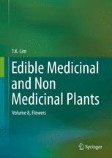Search
Search Results
-

-
Cinnamtannin A2 protects the renal injury by attenuates the altered expression of kidney injury molecule 1 (KIM-1) and neutrophil gelatinase-associated lipocalin (NGAL) expression in 5/6 nephrectomized rat model
Present investigation determines the protective effect of Cinnamtannin A2 against chronic renal failure (CRF). 5/6 nephrectomized rat model was used...

-
A metabolic perspective of selection for fruit quality related to apple domestication and improvement
BackgroundApple is an economically important fruit crop. Changes in metabolism accompanying human-guided evolution can be revealed using a multiomics...

-
Making Cocoa Origin Traceable
Nowadays, consumers have become aware of different cocoa genotypes and their origins, which caused an expanding market of premium chocolates with...
-
Which East Asian herbal medicines can decrease viral infections?
Whilst Western research for the COVID-19 crisis focuses on vaccination, in East Asia traditional herbal prescriptions are studied for SARS-CoV2...

-
Preparative separation and bioactivity of oligomeric proanthocyanidins
Oligomeric proanthocyanidins are among the most widely distributed polyphenols in the plant kingdom, being endowed with antioxidant,...

-
Gibberellic Acid Induces Unique Molecular Responses in ‘Thompson Seedless’ Grapes as Revealed by Non-targeted Metabolomics
Compact clusters and small berry size are the major problems associated with the commercialization of table grapes. The application of gibberellic...

-
Ethnomedicine and Role of Plant Metabolites
Plants have been used for the treatment of various human ailments since ancient times. Bioactive compounds of plant origin are of great interest in...
-
Chemometric evaluation of cocoa (Theobroma cacao L.) and coffee (Coffea spp.) germplasm using HPTLC
The selection of fine flavour cocoa and coffee varieties can lead to attractive niche markets but germplasm need to be analysed for non-volatile...

-
Natural Products as Potential Leads Against Coronaviruses: Could They be Encouraging Structural Models Against SARS-CoV-2?
New coronavirus referred to SARS-CoV-2 has caused a worldwide pandemic (COVID-19) declared by WHO. Coronavirus disease 2019 (COVID-19) is an...

-
A lab-scale model system for cocoa bean fermentation
Lab-scale systems modelling the spontaneous cocoa bean fermentation process are useful tools to research the influence of process parameters on the...

-
Plant cell culture technology in the cosmetics and food industries: current state and future trends
The production of drugs, cosmetics, and food which are derived from plant cell and tissue cultures has a long tradition. The emerging trend of...

-
Secondary Metabolite Credentials and Biological Properties of Litchi chinensis
Litchi (Litchi chinensis Sonn.) is a medium sized evergreen tree indigenous to China, Vietnam, Indonesia and Philippines. Litchi and its different...
-
Bioactive Compounds and Medicinal Importance of Litchi chinensis
Litchi chinensis Sonn. has been widely used as anti-cancer, antiseptic, hypoglycemic, antihyperlipidemic, antiplatelet, antitussive, analgesic,...
-
Lychee (Litchi chinensis): Biochemistry, Panacea, and Nutritional Value
Lychee is an evergreen tree of the genus Litchi in the soapberry family, mostly grown in China, India, Thailand, Vietnam, and the rest of tropical...
-
ROS-induced oxidative stress and apoptosis-like event directly affect the cell viability of cryopreserved embryogenic callus in Agapanthus praecox
Key message Oxidative stress and apoptosis-like programmed cell death, induced in part by H 2 O 2 , are two key factors that damage cells during plant...

-
Callus cultures of Hypericum perforatum L. a novel and efficient source for xanthone production
Hypericum perforatum callus cultures exhibited qualitatively and quantitatively different phenolic profile compared to wild-growing plants (WGP)....

-
The genus Lindera: a source of structurally diverse molecules having pharmacological significance
Lindera plants not only have good ornamental and economic uses but also have great medicinal and therapeutic values. The genus Lindera consists of...

-

-

